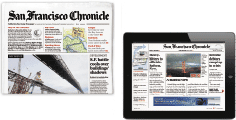In five years, U.S. Secretary of Education Arne Duncan hopes the sight of students hunched over because of textbook-filled backpacks will be a thing of the past.
"These are really tough economic times, but I've been very public that we need to move from print to digital as fast as we can," Duncan said Wednesday outside of Sequoia High School in Redwood City, one of the first stops on his Back-to-School Bus Tour promoting digital education.
Swapping textbooks for e-readers might seem unthinkable for school districts that are receiving fewer state dollars year after year. But Duncan cited the case of Moorseville, N.C., which started providing MacBooks instead of new textbooks to about 4,400 students in the district and saw test scores rise while continuing to rank at the low end of per-pupil spending in the state.
Principal Bonnie Hansen said digital textbooks for all 2,000 students at Sequoia High in five years is "absolutely" possible, and agreed with Duncan that it may not be a financial burden for school districts.
"A physics book today cost $120. We're getting to a point where it's going to be cheaper for kids to have the handheld devices than it is for them to have the textbooks," she said.
What Duncan didn't mention is that Moorseville had to lay off 65 school district employees, including 37 teachers, to fund the program, according to the New York Times. He said that educators should have nothing to fear about technology.
"Technology will never replace teachers," he said. "I think the optimal thing we're aiming for is great teachers getting access to great technology."
One day after giving a speech on digital education at Stanford University, Duncan moderated a panel discussion at Sequoia High among teachers and business leaders who support technological integration in the classroom. He also praised California's 2011 passage of the state's version of the Dream Act, allowing illegal immigrants to receive state financial aid to attend public colleges.
"Nationally, we have to pass the Dream Act," he said. "We can't afford to keep talent on the sidelines."
Panelist Catlin Tucker, a Sonoma County English teacher, said she's allowed students to use their cell phones in class to take part in discussions and has never had a problem with distractions.
"As soon as the phone is included, the attention and participation is heightened," said Tucker, who has written a book on classroom technology. "This is how they engage with the world."
The digital education movement hasn't taken over Sequoia High just yet. Student Council President Marina Poole said the only evidence of new technology over more traditional methods of teaching methods were wireless clickers students used in a physics class to answer lecture questions. She said there would be pros and cons to replacing pencils and books with iPads and smartphones.
"I could definitely see it as a distraction for a lot of kids," she said. "I would hope people wouldn't abuse it."
Neal J. Riley is a San Francisco Chronicle Staff Writer. E-mail: nriley@sfchronicle.com Twitter: @realdealneal


 Traffic
Traffic


 Comments (
Comments (
 Printable Version
Printable Version Email This
Email This Font
Font Email This
Email This













